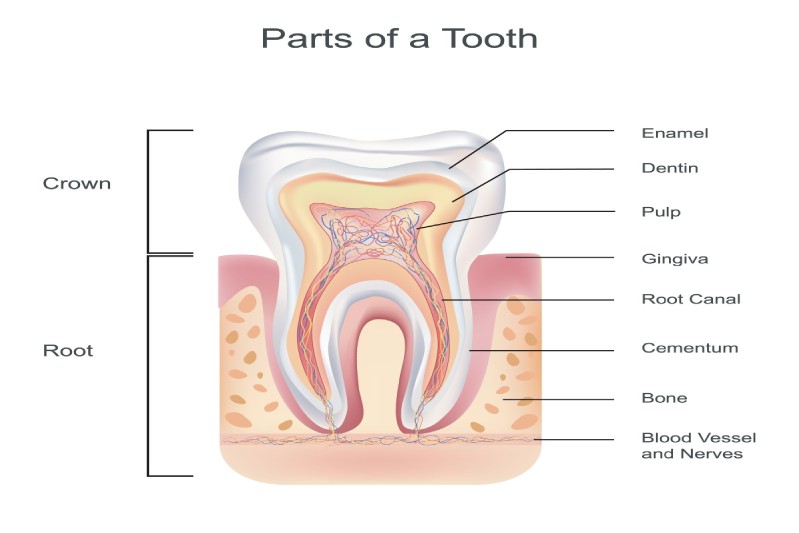
Blog Summary: Learn about the structure of teeth and its impact on oral health and overall health with dental expert Dr. Kami Hoss. Specifically, this blog covers:
- The basic structure (makeup) of human teeth
- The 5 sides of a tooth (topography)
- The 4 types of teeth and their respective functions
- Breakdowns in tooth structure such as cavities and fracture lines
- The cost of replacing a tooth with a broken-down structure
- How to preserve the structure of teeth with smart oral health habits
You’ve got 32 of them (and your little ones have 20), but how well are you acquainted with each one? We’re talking about your teeth.
Every time you’ve gone to the dentist, you’ve probably heard a whole lot about the importance of routine dental care and hygiene to your oral and overall health.
But how well has your dentist helped you understand the anatomy and structure of your teeth?
You may not realize it, but your teeth are made up of many layers that help you chew and speak. Understanding the various parts of a tooth will help you take care of them better. This is especially important because although they may resemble bones, which regenerate, teeth are not structurally the same as bones.
If your teeth decay and are not fixable with a crown, cap, inlay, onlay, or filling, they must be replaced entirely, which can be extremely expensive, even with dental coverage! The cost of replacing a single tooth is about $3,000-$4,000 on average.
So, let’s explore the structure of teeth now.
What is the Structure of a Human Tooth?
There are a few main components of a tooth, as shown in our structure of teeth diagram at the top of this blog post. These include:
- Pulp
- Dentin
- Enamel
- Cementum
- Root
- Gingiva
At the center of the tooth is the pulp, which contains blood vessels, nerves, and connective tissue.
Surrounding the pulp is dentin, a hard substance that makes up the majority of the tooth. Finally, the outer layer of the tooth is made up of enamel, which is the hardest substance in the human body, even harder than bone.
The tooth is anchored into the jawbone by a root, which is covered in a layer of cementum. The gums, or gingiva, surround the base of the tooth, helping to protect it from damage and infection.
How to Preserve Tooth Structure & Health
- Brush Smart: Choose your toothbrush wisely. Using one with soft bristles and brushing at a 45-degree angle to the gumline is important to removing bacteria and plaque while preserving enamel. Don’t brush too hard, which can cause the gumline to recede.
- Use Enamel-Strengthening Products: Fluoride treatments are effective for adults or teens with safe swallowing skills, but products with Hydroxamin are equally helpful.
- Prevent Fractures: Avoid foods that promote fracture lines and consider a mouth guard if you grind your teeth.
- Eat Tooth-Friendly Foods: It’s not just about avoiding hard candies; you want to also think about the pH of a food and its effect on the oral microbiome.
What are the 5 Sides of a Tooth’s Structure?
A tooth has five different sides, each of which plays an important role in its overall structure and function:
- The crown is the top part of the tooth that is visible above the gum line. It is covered in enamel, which protects the underlying layers of the tooth.
- The root is the bottom part of the tooth that is anchored into the jawbone. It is covered in cementum, which helps to hold the tooth in place. The root of a tooth does not have enamel.
- The mesial side is the part of the tooth that is closest to the center of the mouth. For example, the mesial side of your front teeth would be the side that faces your other front teeth.
- The distal side is the part of the tooth that is farthest away from the center of the mouth. For example, the distal side of your front teeth would be the side that faces away from your other front teeth.
- The occlusal surface is the top part of the tooth that is used for chewing and grinding food. It is typically flatter than the other sides of the tooth to make it easier to grind up food.
What are the 4 Types of Teeth & Their Structure?
All teeth are made up of the same basic structure (pulp, dentin, enamel, cementum, root, and gingiva). The difference between types of teeth is how they’re shaped. These different shapes enable teeth to have different chewing functions:
- Incisors: Help you tear food while you bite
- Canines: Help you eat fibrous foods like meat and crunchy foods like vegetables
- Premolars: Help you tear, crush, and grind food
- Molars: Help you mash, crush, and grind food
The Most Common Parts of a Tooth Where Cavities Occur
Understanding the structure of a tooth is crucial to understanding where cavities are most likely to occur, and therefore can help you focus your oral hygiene on those areas, which are more prone to decay than others.
Chewing Surface: The chewing surface of your molars is a common area for cavities to form. These surfaces are covered in small grooves and pits that can be difficult to clean, making them a prime location for bacteria to thrive.
Gap Between Teeth: The area where two teeth meet is also a common spot for cavities to form. This area can be difficult to reach with a toothbrush, which can allow plaque and bacteria to build up.
That being said, any area of the tooth that is not cleaned properly can be at risk for cavities. This is why it is important to regularly brush and floss properly to remove plaque and bacteria from all areas of the tooth.
What are Fracture Lines?
Fracture lines are cracks or breaks in your tooth structure usually caused by chewing hard foods, grinding teeth, or blunt force trauma.
These are deep fractures that extend into the underlying layers of teeth making them difficult to detect.
Some common signs of a tooth fracture include:
- Pain when biting or chewing
- Sensitivity to hot or cold temperatures
- Swelling or tenderness around the affected tooth
- A visible crack or chip in the tooth
Treatment options for a tooth fracture depend on the severity and location of the fracture, as well as the overall health of the tooth. For minor fractures, a dental filling or bonding may be sufficient to restore the tooth’s structure and function.
It’s important that you visit us if you believe you have a tooth fracture.
In Conclusion
Now that you have a better understanding of your teeth and their structure, we hope you are better-motivated to take care of yours! Check out more info on how to do that by reading our blog post “Developing a Healthy Oral Hygiene Routine: 7 Daily Best Practices”.
Looking for a more comprehensive resource to learn just about everything there is to know about your oral health? Read Dr. Kami’s new book, If Your Mouth Could Talk!

